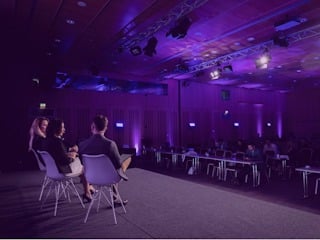On one hand, this makes sense. The consumer is the person with the most control of a company’s bottom line, of course technological advances that make their lives easier and makes it more likely they’ll return and spend more money take precedence. However, what about tech that helps employees do their jobs better?
One headache for retail brands when it comes to innovation is how expensive creating and testing a new technology can be. Given the cost, it’s far more important that any potential change will result in profit, and the technology changes that most immediately result in more cash in the till are the ones dedicated to helping make the customer’s life easier.
The good news is that in today’s world of needing to bring exceptional experiences to brick-and-mortar locations in order to best compete with digitally native brands, advances that help your employees perform their duties also help improve the shopping experience for customers.
Programs and apps making use of voice commands are one innovation that has the potential to improve both the shopping experience of customers—causing them to come back again and again—and the job performance of employees.
Proving What’s Possible With Voice Recognition
In order to prove what’s possible with the voice recognition technology currently available, we built out a few simple POCs. With minimal equipment and very low investment, brands can bring entirely new experiences to both customers and employees.
For a retail outlet that specialises in creating custom clothing, selling tailored clothing or even altering existing clothing items, our voice activated tailor app could be the perfect addition. Typically, a tailor needs to take a customer’s measurements, and then at least record those measurements somehow. It’s a fairly simple process as is, but what if you could simplify further and add customer interaction to make the process more cooperative and less one-sided?
 Instead of needing the tailor to write or key in measurements, we thought it would be fun to create an app that listens for specific keywords (words like neck, waist, inseam, etc) and then records the measurements and keeps the information organised. But there’s a difference between a person’s measurements and the way they like their clothes to fit, so instead of simply allowing the tailor to record their measurements and go from there, the app allows for the customer to make statements that will overwrite the initial measurement. Because the POC is constantly listening for the trigger words, it will record the most recent measurement mentioned after the trigger word is said.
Instead of needing the tailor to write or key in measurements, we thought it would be fun to create an app that listens for specific keywords (words like neck, waist, inseam, etc) and then records the measurements and keeps the information organised. But there’s a difference between a person’s measurements and the way they like their clothes to fit, so instead of simply allowing the tailor to record their measurements and go from there, the app allows for the customer to make statements that will overwrite the initial measurement. Because the POC is constantly listening for the trigger words, it will record the most recent measurement mentioned after the trigger word is said.
The ability for the associate to say a measurement and then the customer to correct them provides a small change to the process that helps the customer to feel even more involved. This is particularly useful in an industry where customer input is crucial for the execution of something custom made. However, even when picking through a collection of stock items in their size, this kind of interaction can be invaluable.
While the POC is simple right now, functioning mostly in recording spoken information and then providing suggestions of stock items that meet those measurements, the possibilities for it are vast. For example, connecting it not only to a store’s physical inventory but also to all of the options available through the store’s website would allow it to pull from a wider range of options and initiate an online order to compliment the work being done in the brick-and-mortar location.
This could also be the starting point for the creation of a customer profile, recording things like measurements, colour preferences, unique style quirks and other personalisation elements that would help in making increasingly more accurate suggestions as well as recording previous purchases to better send notifications when new items come into stock that fit a customer’s purchase history.
This is an example of a simple and straightforward POC using voice. Like most voice interface technology, it listens for specific words or phrases and then performs a task. To kick things up a notch, you need an app that’s always listening and accurately recording important information.
For our clienteling POC, we wanted to see if a program could listen to a conversation between an associate and a customer and pick out the words and phrases that would help to build a useful customer profile and even process an order.
The beauty of this POC is its always-on functionality. Because it isn’t listening for keywords to trigger an action, it’s better able to pick up on words and phrases and fill in the necessary field with that information. Without the need for trigger words or even for the associate to follow a strict script, the conversation can be natural while still accomplishing a task.
Much like the tailoring POC, the possibilities for this clienteling app are vast. It could easily be adapted to different industries, allowing for financial advisors to record important goals/lifestyle information for their clients and then create a savings plan, or even in healthcare it could be used as a quick way for doctors to gather a lot of information and, through AI integration, even make a diagnosis or suggest treatment options.
The Benefits of Leaning in With Voice
When a customer or client is sharing information, things like eye contact and not being interrupted are crucial for feeling heard and valued. Culturally, we talk a lot about the importance of eye contact and nonverbal communication and yet we put store associates at a disadvantage by forcing them to look at screens while interacting with customers. Through voice interfaces like these, we gain the ability to make customers feel like they’re the centre of attention, which is the easiest way to make sure they come back.
For the associate, being able to trust an app to record all of the important information in a natural conversation and then to make product suggestions, it changes the way we can train associates in interacting with customers, providing more natural and human interactions all around while prioritising high-level people skills more than rote memorisation of facts about different products.
Moreover, for the POCs explored here, the cost of implementation is quite low. The software to create a fully integrated and functioning system making use of the simple voice commands and interfaces we’ve shown here is readily available, and the hardware requirements are minimal. Meaning that any brand looking to create a new and unique experience can do so with
a small investment they’d be sure to see a quick return on.
For a number of different reasons, voice Interface technology is poised to be a big part of our future. Instead of waiting for the competition to get there first, leaving you to play catch up, why not lead the pack?








